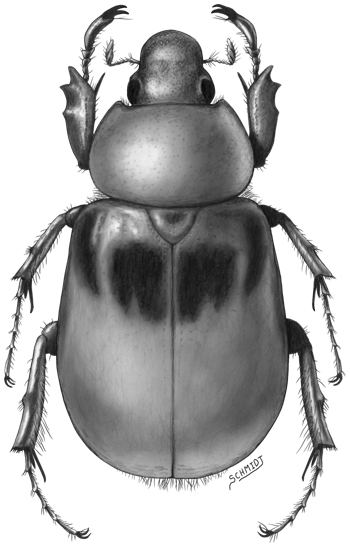 |
|||||||
|
|||||||
|
||
|
||
| Dynastinae Taxa Map | ||
........Barotheus Bates 1891: 30 (synonym).
........Pseudancognatha Otoya 1945: 275 (synonym, described as subgenus).
Ancognatha sellata.
Illustration by Dan Schimdt.
Distribution: From Arizona and New Mexico in the United States south to southern Ecuador, Peru, and Bolivia (Endrödi 1966, 1985a; Ratcliffe 1992a).
Composition: 19 species.
Diagnosis: The elongate, generally acuminate or narrowly parabolic form of the clypeus has been used to distinguish Ancognatha from other genera of Cyclocephalini. Species of Mimeoma also have an acuminate clypeus, but they do not have the deeply incised or distinctly emarginate mentum seen in Ancognatha species. The clypeal apex in some species of Ancognatha is parabolic or rounded, and they share this character state with many species of Cyclocephala. Again, however, the form of the mentum in Ancognatha species (and their generally larger size) will separate them from Cyclocephala species. Bates (1888) noted that in Ancognatha species the labrum is detached and inclined from the roof of the mouth instead of being hidden as in Cyclocephala. The very narrow, upwardly pointed mandibles are also characteristic of most species of Ancognatha. The frontoclypeal suture is obsolete medially in Ancognatha species, whereas it is more or less complete in Cyclocephala and Aspidolea species. The protarsus in the males is always enlarged.
Larvae: The larval stage has been described for only two species in the genus, A. manca LeConte from the southwestern U.S. and northern Mexico and A. sellata Arrow from Mesoamerica.
Biological notes: Adults of Ancognatha species are attracted to lights at night, but little else is known of their life history. Most species occur only in highland areas.
Revision or Synopsis: Endrödi (1966, 1985a) provided the last comprehensive review of the species of Ancognatha.
Literature cited:
Bates, H. W. 1888. Pectinicornia and Lamellicornia, Family Dynastidae. In, Godman, F. D. and O. Salvin (editors), Biologia Centrali-Americana. Insecta, Coleoptera, Volume 2, pt. 2: 296-342.
Endrödi, S. 1966. Monographie der Dynastinae (Coleoptera, Lamellicornia). I. Teil. Entomologische Abhandlungen 33: 1-460.
Endrödi, S. 1985a. The Dynastinae of the World. Dr. W. Junk Publisher, Dordrecht. 800 pp., 46 plates.
Ratcliffe, B. C. 1992a. A new species of Ancognatha from Panama (Coleoptera: Scarabaeidae: Dynastinae). Coleopterists Bulletin 46: 256-259.
|
||||
|
|
